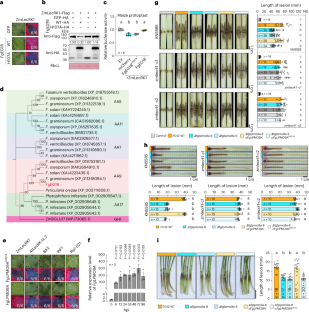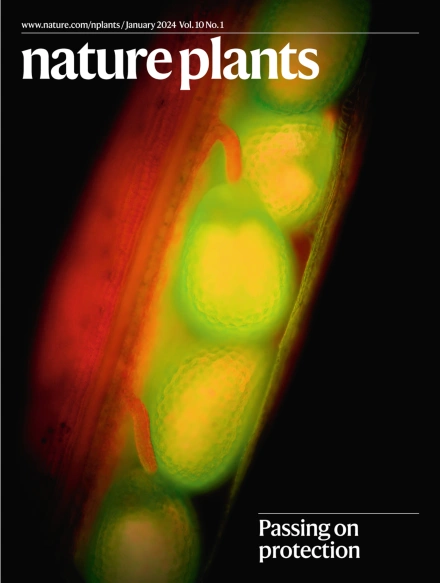外胞体真菌效应物破坏ZmLecRK1的n -糖基化,诱导其降解以抑制玉米的抗病能力
IF 13.6
1区 生物学
Q1 PLANT SCIENCES
引用次数: 0
摘要
病原体利用效应物抑制宿主的免疫反应,使其能够在植物中成功定植。虽然胞外效应物在致病性中起主要作用,但它们是否以及如何直接攻击细胞外免疫受体仍不清楚。本研究从真菌致病菌禾谷镰镰菌中鉴定出一种胞外效应物FgLPMO9A,可直接抑制玉米免疫受体zmlecrk1介导的抗性。FgLPMO9A属于多糖单加氧酶家族,其作用是解聚多糖。FgLPMO9A基因的缺失会减弱玉米致病性,但这一缺陷在zmlecrk1突变体中完全恢复。FgLPMO9A与ZmLecRK1的胞外s结构域相互作用,破坏N341位点的n -糖基化,从而通过nbr1介导的自噬途径促进ZmLecRK1降解。值得注意的是,具有N341Q替换的ZmLecRK1变体增强了玉米对F. graminearum的抗性。我们证明了F. graminearum通过部署胞外效应诱导细胞外免疫受体降解来抑制玉米免疫。本文章由计算机程序翻译,如有差异,请以英文原文为准。


An apoplastic fungal effector disrupts N-glycosylation of ZmLecRK1, inducing its degradation to suppress disease resistance in maize
Pathogens deploy effectors to suppress host immune responses and enable successful colonization in plants. While apoplastic effectors have major roles in pathogenicity, whether and how they directly attack extracellular immune receptors remains unclear. Here we identify an apoplastic effector FgLPMO9A from the fungal pathogen Fusarium graminearum that directly inhibits maize immune receptor ZmLecRK1-mediated resistance. FgLPMO9A belongs to the polysaccharide monooxygenase family, which depolymerizes polysaccharides. Deletion of FgLPMO9A attenuates F. graminearum virulence on maize, but this defect is fully rescued in the zmlecrk1 mutants. FgLPMO9A interacts with the extracellular S-domain of ZmLecRK1 and disrupts N-glycosylation at the N341 site, thereby promoting ZmLecRK1 degradation via the NBR1-mediated autophagy pathway. Notably, the ZmLecRK1 variant with the N341Q substitution confers enhanced resistance to F. graminearum in maize. We demonstrate that F. graminearum dampens maize immunity by deploying an apoplastic effector to induce extracellular immune receptor degradation. This study reveals that a fungal apoplastic effector dampens plant immunity by disrupting the N-glycosylation of a cell-surface immune receptor, thereby promoting its autophagy-mediated degradation and providing insights into plant–pathogen interactions.
求助全文
通过发布文献求助,成功后即可免费获取论文全文。
去求助
来源期刊

Nature Plants
PLANT SCIENCES-
CiteScore
25.30
自引率
2.20%
发文量
196
期刊介绍:
Nature Plants is an online-only, monthly journal publishing the best research on plants — from their evolution, development, metabolism and environmental interactions to their societal significance.
 求助内容:
求助内容: 应助结果提醒方式:
应助结果提醒方式:


